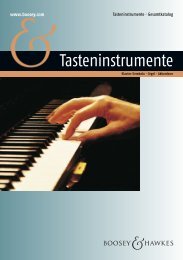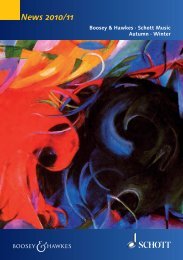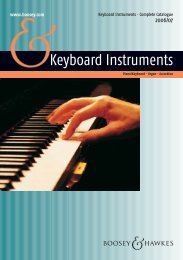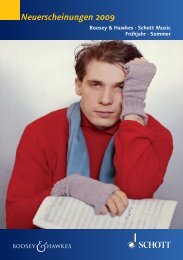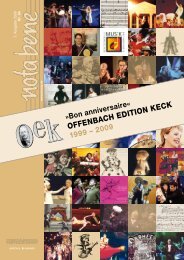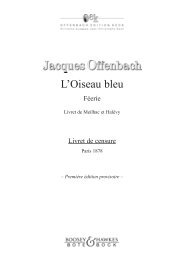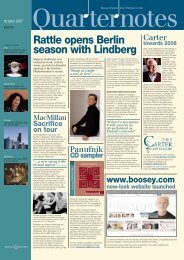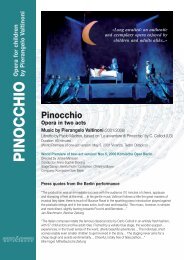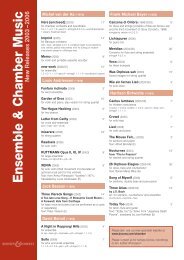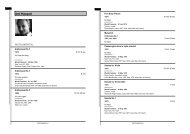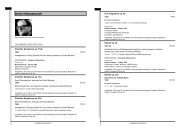New Composers Rachmaninoff
New Composers Rachmaninoff
New Composers Rachmaninoff
Create successful ePaper yourself
Turn your PDF publications into a flip-book with our unique Google optimized e-Paper software.
June 2008<br />
2008/2<br />
Included in this issue:<br />
Andriessen<br />
Interview exploring opera<br />
on Dante’s Commedia<br />
Cherubini<br />
Award-winning edition in<br />
Vienna and Brussels<br />
Marsalis<br />
Leading jazz composers<br />
sign new contracts<br />
Rautavaara<br />
Tapestry of Life premiere<br />
and new CDs<br />
Birtwistle The Minotaur<br />
Harrison Birtwistle’s<br />
thrilling new opera reveals<br />
the half-man, half-beast<br />
As the Sunday Times noted at the Covent<br />
Garden premiere on 15 April, “Harrison<br />
Birtwistle’s latest opera is a piece he might<br />
have been expected to write. The Minotaur, to<br />
words by David Harsent, was commissioned<br />
by the Royal Opera House and premiered<br />
there under Antonio Pappano, and is like a<br />
summary of Birtwistle’s preoccupations.<br />
Greek mythology has rarely been far from his<br />
thoughts. Monstrous beings such as the<br />
Minotaur have regularly featured in his<br />
operas… and labyrinths such as the one<br />
Daedalus made for King Minos, to cage the<br />
Minotaur, have provided Birtwistle with a<br />
principle of form.”<br />
“The most powerful and<br />
original opera yet to have<br />
emerged this century.”<br />
The Scotsman<br />
“Blood-drenched and sorrowful, majestic and raw,<br />
The Minotaur plunders the extremes of human<br />
nature in music of coruscating, storming beauty…<br />
Low woodwind, sensuous strings and the spangly<br />
clatter of the cimbalom colour the orchestra in<br />
sombre, glistening tones. The rewards are at once<br />
unsettling and exhilarating… the applause, though<br />
deserved by all, was primarily for yet further proof<br />
of Birtwistle’s epic creative clarity.” Evening Standard<br />
“…in the Minotaur himself, a role specially<br />
conceived for the bass John Tomlinson, Birtwistle<br />
has created one of his most complex and<br />
fascinating protagonists… It is a dramatic tour de<br />
force for Tomlinson, who handles it superbly and<br />
gives eloquence to a creature who can articulate<br />
Photo: Bill Cooper<br />
his thoughts only in his dreams, and acquires the<br />
power of speech only after the fatal blow has<br />
landed.” The Guardian<br />
“The moment when the beast stands revealed is a<br />
brilliant coup de théâtre. The drama is now both<br />
wonderful and dreadful; as more victims are raped<br />
and gored, blood upon blood, the crowd intones<br />
a drugged and ecstatic chorale brutally shattered<br />
by a screeching chorus of winged furies. Here the<br />
music’s crazy momentum displays Birtwistle’s<br />
talents at magnificently full stretch… the evening is<br />
a glittering success.” The Independent<br />
“He is such a master of orchestration – he<br />
constantly takes the ear to new places, producing<br />
brilliant colours. And no one knows better how to<br />
build a tension, hold it, resolve it. There is hugely<br />
impressive writing for the slaughter of the<br />
innocents, shriek upon shriek cutting a swathe<br />
through the orchestra. Elsewhere, keening high<br />
brass over strings and low brass produces a<br />
mesmerizing effect. The work is broken by three<br />
orchestral toccatas, again with hauntingly beautiful<br />
material.” Opera America<br />
Boosey & Hawkes Music Publishers Limited<br />
John Tomlinson as The Minotaur in Birtwistle's opera at the Royal Opera House, Covent Garden.<br />
<strong>New</strong> <strong>Composers</strong><br />
Qigang<br />
Chen b.1951<br />
Enrico<br />
Chapela b.1974<br />
Boosey & Hawkes is pleased<br />
Mexican composer Enrico<br />
to announce a publishing<br />
Chapela has signed a<br />
contract with Chinese<br />
publishing agreement with<br />
composer Qigang Chen, who<br />
Boosey & Hawkes covering<br />
this year directs the music at<br />
his existing output and future<br />
the opening ceremony of the<br />
works. Chapela is one of the<br />
Beijing 2008 Olympic Games.<br />
most exciting young talents<br />
The new agreement covers Chen’s future to emerge from Latin America, with a<br />
compositions, while his earlier works remain growing number of international<br />
published by Billaudot and Durand.<br />
performances and commissions. Current<br />
Qigang Chen was studying music as a<br />
teenager at the Central Conservatory of<br />
Music at the outbreak of the Cultural<br />
Revolution in 1966. He was confined for<br />
three years and underwent “ideological reeducation”,<br />
yet went on learning composition<br />
despite social and political anti-cultural<br />
pressures. In 1977 the state reopened entry<br />
to the Conservatory and he studied there for<br />
five years with Luo Zhongrong.<br />
In 1983 Chen won a postgraduate contest to<br />
travel abroad, and for four years was<br />
Messiaen’s only student after the master’s<br />
retirement from the Paris Conservatoire. He<br />
described how Chen’s compositions “show<br />
real inventiveness, very great talent and a total<br />
assimiliation of Chinese thinking with<br />
European musical concepts.” Chen has<br />
received commissions from Radio France,<br />
Deutsche Kammerphilharmonie, Stuttgart<br />
RSO, Orchestre Symphonique de Montréal<br />
and the Koussevitzky Foundation. He was<br />
composer-in-residence at the Strasbourg<br />
Philharmonic from 2004 to 2006.<br />
projects include a rock trio concerto for the<br />
Dresden Sinfoniker for premiere in<br />
September, a new work for the NYDD<br />
Ensemble in Tallinn, and a commission from<br />
the Los Angeles Philharmonic for<br />
performance in the Green Umbrella new<br />
music series in 2009.<br />
Chapela studied guitar and composition at<br />
the Centro de Investigación y Estudios de la<br />
Música in Mexico City, and has combined<br />
activities as a guitarist with further studies at<br />
the University of Paris at St Denis. His<br />
musical style fuses different geographic<br />
traditions and musical soundworlds, so that<br />
contemporary techniques happily coexist<br />
with minimalist, jazz or rock idioms. This<br />
dialogue of cultures is not ‘world music’, but<br />
rather a place where jam sessions can meet<br />
complex metrical games, where the anarchic<br />
drive of favela buskers can collide with the<br />
chants of football fans.<br />
Chapela’s symphonic poem Ínguesu has<br />
travelled widely since its premiere by the<br />
Carlos Chavez Symphony Orchestra in<br />
2003, including a North American tour last<br />
Works that have travelled internationally autumn by the Philharmonic Orchestra of<br />
include Iris devoilée (2001) for orchestra, the Americas. The Dallas <strong>New</strong>s described<br />
female voices and Chinese instruments, how the work “transmutes the cheers and<br />
available on a highly successful Virgin<br />
jeers of the 1999 Mexico vs. Brazil soccer<br />
Classics disc (7243 5 45549 2 6), and Raise match into an Ivesian collage of chatter,<br />
the Red Lantern (2002), a full-evening ballet blast and slide.” The work can be heard on<br />
for National Ballet of China directed by a CD Baby disc entitled Antagónica,<br />
Zhang Yimou. Future projects include an together with the saxophone quartet La<br />
orchestral work for the Hong Kong<br />
Mengambrea and Lo Nato es Neta for rock<br />
Philharmonic and a second ballet.<br />
trio and acoustic quintets.<br />
Photo: Frank Harders<br />
Photo: Peter Joslin/ArenaPAL<br />
“The music begins like flowing magma, muffled<br />
and dark, forming itself frequently à la Alban Berg<br />
into a lengthy adagio... A few times there is<br />
opportunity for excessive, indeed explosive visions<br />
of sound using the powerful range of percussion,<br />
particularly in depicting the murderous acts of the<br />
beast… Even the end of the Minotaur is dazzlingly<br />
reaffirmed in this manner… Compared with<br />
somewhat fussy myth adaptations such as Ulisse<br />
by Dallapiccola or some of Henze’s late works,<br />
Birtwistle demonstrates absolutely the hand of a<br />
heady, heavyweight storyteller-in-sound.”<br />
Frankfurter Rundschau<br />
“It is that rare beast –<br />
a successful new opera.”<br />
Bloomberg <strong>New</strong>s<br />
With the premiere of The Minotaur and two<br />
productions of Punch and Judy, London<br />
was the epicentre of Birtwistle attention this<br />
spring. The operatic focus shifts abroad later<br />
in the year with the Italian premiere of The<br />
Last Supper as part of a Birtwistle feature at<br />
Settembre Musica in Turin and Milan<br />
(4-11 September), and the German premiere<br />
of The Io Passion at the Berlin Kammeroper<br />
(7-16 November).<br />
Mackey<br />
in Manchester<br />
The music of Steven<br />
Mackey is celebrated in<br />
Manchester between 16<br />
and 18 June, with 13 of his<br />
works performed across<br />
three days. The Spring-<br />
Loaded event combines<br />
concerts by Psappha, the<br />
BBC Philharmonic and<br />
students at the Royal Northern College of<br />
Music. Highlights include the UK premieres<br />
of Measures of Turbulence for eight guitars<br />
and of the electric cello concerto<br />
Banana/Dump Truck with its dedicatee Fred<br />
Sherry as soloist. Also in the final orchestral<br />
concert, conducted by Clark Rundell, are<br />
Lost and Found, Turn the Key and Eating<br />
Greens, offering a showcase of Mackey’s<br />
exuberant and zany style.<br />
Mackey is currently completing a violin<br />
concerto, Beautiful Passing, commissioned<br />
by the BBC and Saint Louis Symphony for<br />
Leila Josefowicz, which promises to travel<br />
through both antagonistic and tranquil<br />
territories. HK Gruber conducts the world<br />
premiere in Manchester with the BBC<br />
Philharmonic on 24 October and David<br />
Robertson the US premiere performances in<br />
Saint Louis on 14 and 15 November.<br />
Mackey describes how “the governing<br />
metaphor of the concerto has to do with the<br />
violin gaining control of its own destiny,<br />
competing with, commanding and ultimately<br />
letting go of the orchestra. This metaphor<br />
arises from my experience, during the<br />
composition of the piece, watching my<br />
mother gain control of her destiny to the<br />
point of predicting the day she would let go,<br />
predicting the day of her death. Her last<br />
words to me were: “Please tell everyone I<br />
had a beautiful passing”.<br />
<strong>Rachmaninoff</strong><br />
concerto from symphony<br />
This autumn brings the first concert<br />
performance of a new arrangement of<br />
<strong>Rachmaninoff</strong>’s Symphony No.2,<br />
transformed into a three-movement piano<br />
concerto with a duration of 42 minutes.<br />
<strong>Rachmaninoff</strong> was himself ranked among an<br />
elite group of expert piano transcribers<br />
together with Liszt, Godowski and Busoni,<br />
and the new arrangement by Russian-born<br />
performer and composer Alexander<br />
Warenberg similarly aims to recast this<br />
much-loved orchestral music into a form for<br />
performance by virtuoso pianists.<br />
The Paris premiere of Piano Concerto “No.5”<br />
at the Salle Pleyel on 21 November features<br />
<strong>Rachmaninoff</strong> specialist Denis Matsuev and<br />
the Orchestra Philharmonique de Radio<br />
France conducted by Vladimir Spivakov. The<br />
all-<strong>Rachmaninoff</strong> programme, presented in<br />
collaboration with the Serge <strong>Rachmaninoff</strong><br />
Foundation, also includes Symphonic<br />
Photo: Alice Arnold<br />
Dances and Matsuev performing the recently<br />
rediscovered Suite in D minor and Fugue in<br />
D minor, as heard on his acclaimed Sony<br />
BMG recording (88697155912).<br />
The initial idea to create Piano Concerto<br />
“No.5” came from record producer Pieter<br />
van Winkel who was responsible for its first<br />
recording on Brilliant Classics (8900) with<br />
soloist Wolfram Schmitt-Leonardy, the<br />
Janá÷ek Philharmonic Orchestra and<br />
Theodore Kuchar. A reviewer in FonoForum<br />
praised the skill and sensitivity of<br />
Warenberg’s arrangement:<br />
“With the exception of occasional small<br />
retouchings, Warenberg leaves<br />
<strong>Rachmaninoff</strong>’s tonal language, his melody,<br />
style of writing and instrumentation,<br />
untouched. And in the newly-added solo<br />
part, he demonstrates a perfect sensitivity for<br />
the work with his characteristic piano writing.<br />
It sounds from beginning to end like “real”<br />
<strong>Rachmaninoff</strong>. All in all, Warenberg must be<br />
credited with having perfectly assimilated<br />
<strong>Rachmaninoff</strong>’s sound world, and he has<br />
succeeded in creating a concerto not only<br />
based on his music, but also in his style.”<br />
The Serge <strong>Rachmaninoff</strong> Foundation is<br />
supporting a project by the BBC<br />
Philharmonic under Gianandrea Noseda to<br />
reassess the composer’s Symphony No.1,<br />
scarred for a century since its disastrous<br />
premiere in 1897. A new Chandos recording<br />
is released this month and the orchestra<br />
presents the symphony on 11 August within<br />
the BBC Proms’s <strong>Rachmaninoff</strong> feature. All<br />
three symphonies can be heard in the<br />
London Symphony Orchestra’s<br />
<strong>Rachmaninoff</strong> weekend conducted by Valery<br />
Gergiev (20-21 September).
Photo: Matt Stuart<br />
Andriessen La Commedia<br />
Louis Andriessen discusses his new opera, premiered in Amsterdam on 12 June.<br />
When was your interest in Dante’s La<br />
Commedia first kindled?<br />
I’ve had an ongoing interest in Dante<br />
for close on 30 years. At the time of<br />
writing De Tijd I was researching<br />
possible texts in Florence. The work<br />
finally ended up using a text by St<br />
Augustine, but I did retain as a motto<br />
a phrase from the Paradiso section of<br />
Commedia that describes “gazing on<br />
the point beyond which all times are<br />
present”.<br />
How did the idea for a full-length<br />
opera come into being?<br />
I’d always wanted to return to<br />
Dante’s Florence by writing in Italian,<br />
and this came about through hearing the singer<br />
Cristina Zavalloni, who for me was the first since<br />
Cathy Berberian to produce the right vernacular<br />
quality. I wrote Racconto dall’inferno for her, a<br />
grotesque scherzo setting texts from the Inferno<br />
section of La Commedia, and the idea of a fullevening<br />
stagework grew from there, with Racconto as<br />
the second of the five scenes.<br />
What in essence does opera mean to you?<br />
The nineteenth century opera tradition has never<br />
meant a lot to me – my favourite operas are the Bach<br />
Passions. I’ve probably spent more of my time<br />
watching movies, whether Tom and Jerry or Fellini.<br />
But I have always been interested in theatre, and its<br />
relations with other artforms including singing. I’ve<br />
worked in theatres from the age of 14 and was<br />
particularly active in this area in the 1970s with the<br />
Baal group, which tried to recapture the spirit of<br />
Brecht and Weill. This led to all manner of mixedmedia<br />
collaborations including film and dance as well<br />
as music.<br />
You’ve titled La Commedia a ‘film opera’ and are<br />
working with director Hal Hartley.<br />
Yes, we were brought together for the first time in<br />
2000 on a short film with music called The <strong>New</strong><br />
Math(s), and then on a theatre project Inanna. My<br />
experience working with visual artists is that you can<br />
suggest a few images but largely you have to allow<br />
their mind’s eye to work – it was the same<br />
collaborating with Robert Wilson for De Materie and<br />
with Peter Greenaway. With Hal Hartley I’ve spent<br />
most time discussing moods and my choices of texts,<br />
and how ideas are linked to the paintings of heaven<br />
and hell by Hieronimus Bosch. The film footage is<br />
totally contemporary, but I’ve seen a section where a<br />
gang of street musicians is a perfect modern<br />
equivalent to a Bosch painting.<br />
MacMillan<br />
St John Passion<br />
“James MacMillan has delivered a St John Passion<br />
that stirred its premiere audience to a standing<br />
ovation.” So wrote The Independent, witnessing the<br />
spontaneous public response to this major new<br />
choral-orchestral work, composed as an 80th<br />
birthday present for Sir Colin Davis at the helm of the<br />
London Symphony Orchestra and Chorus. The first<br />
performance was clearly as significant for the religious<br />
as for the musical community, as noted by The<br />
Observer: “It is not often you see the Archbishop of<br />
Canterbury lead a standing ovation… Clearly, the<br />
archbishop shared the ecstatic audience’s view that a<br />
great new work had entered the repertoire”.<br />
James MacMillan with Sir Colin Davis at rehearsals.<br />
In recent years Colin Davis has championed<br />
MacMillan’s music, making the composer a natural<br />
choice to create this special score. Following the<br />
London premiere and recording for the LSO Live<br />
label, Davis will conduct performances of the St John<br />
Passion with the Royal Concertgebouw Orchestra in<br />
Amsterdam on 8/9 April 2009, and with the Boston<br />
Photo: Francesca Patella<br />
How did you select the texts from the<br />
complete Commedia?<br />
The first principle was to select<br />
sequences of material in the same<br />
order as in Dante’s book. So the first<br />
two scenes take us from the City of<br />
Dis down through Inferno to the<br />
deepest regions of hell where we<br />
meet Lucifer in the third part. This is<br />
where Adam’s Fall is described. We<br />
then pass upward through the lighterhearted<br />
Garden of Earthly Delights<br />
until we reach Paradise in the final<br />
section, Eternal Light.<br />
How do the comic and serious<br />
elements balance in the work?<br />
This is quite a complicated question to answer. Dante<br />
would simply have viewed comedy in the Greek<br />
sense where it is a form of serious drama that has a<br />
happy ending. The adjective ‘Divine’ was only added<br />
to Dante’s title in the 16th century, some 200 years<br />
after the book’s completion around 1320, so the<br />
religious aspect of Commedia is really only within an<br />
overall social, political and essentially humanist<br />
framework. This is why I view the text as being more<br />
concerned with our life on earth than with any afterlife,<br />
and Dante’s comic vehicle for this observation was<br />
irony, which really appealed to me. Irony is what<br />
generates the drama in my opera – a satirical view of<br />
heaven and hell in our everyday life. There are comic<br />
and serious sides to this irony which play off each<br />
other in a dialectic manner. The lightness is balanced<br />
with melancholy – something I also hear in the music<br />
of Stravinsky and Poulenc - and I’ve tried to offset<br />
serious with popular music, such as in the swinging<br />
jazz clarinet music that leads us into the Garden of<br />
Earthly Delights.<br />
How did you decide on the vocal forces for the<br />
opera?<br />
I’ve always been more interested in working with<br />
singing actors than acting singers. So the three<br />
principal voices in the opera are not conventional<br />
types. As well as being a contemporary music<br />
specialist, Claron McFadden who sings Beatrice is a<br />
baroque singer with a background in soul and gospel.<br />
Cristina Zavalloni worked first in jazz and experimental<br />
music and brings a unique timbre and Jeroen Willems<br />
is foremost an actor but is also a great performer of<br />
the songs of Jacques Brel. Rather than personifying<br />
the roles of Dante and Lucifer, those two singers<br />
function more as commentators. Then there is a small<br />
chorus of eight solo voices, and a children’s choir that<br />
appears in the final scene.<br />
Symphony Orchestra in the 2009/10 season. The<br />
German premiere takes place on 14 March 2009 with<br />
the Rundfunkchor and Sinfonierchester Berlin<br />
conducted by Simon Halsey.<br />
The vocal forces for the St John Passion are skilfully<br />
layered: a small, plainsong-inflected ensemble<br />
narrates events as if from a timeless illuminated<br />
manuscript, while the full chorus switches between<br />
the mob outbursts of the turba and a series of<br />
reflective motets. The dramatic core of the work is<br />
focused on the baritone role of Christ, “sung with<br />
awesome authority by Christopher Maltman…<br />
MacMillan gives Christ elaborate, declamatory<br />
passages full of anger and bitterness. This is not a<br />
saviour going submissively to the cross, but a<br />
furious rebel” (The Observer).<br />
“Davis is a wily conductor, and never have his instincts<br />
been more accurate. For MacMillan has come up with a<br />
masterly work that has all the hallmarks of a 21st-century<br />
classic… MacMillan is a master of ratcheting up the<br />
tension, building the drama, his subtle use of syncopation<br />
adding to the effect. But he can also turn his hand to the<br />
most lyrical, vulnerable music. There is a tremendous<br />
sense of wonder for Christ’s “This is my body” passage,<br />
and again for the Crucifixus, a dream-like sequence that<br />
seems to exist in another dimension… There is another<br />
mesmerizing passage in “Jesus and his Mother” where the<br />
two choruses sing together, interweaving their lines with<br />
great beauty.”<br />
Musical America<br />
“A riveting and remarkable<br />
work; a new-minted classic”<br />
The Scotsman<br />
“A blazing blockbuster, a piece as fiercely communicative<br />
as anything that the 48-year-old MacMillan has written<br />
before…. The end of Part One was masterly: no<br />
loudspeaker wailing as the Crucifixion loomed, but a<br />
resigned, pianissimo meditation, threaded with keening<br />
instrumental solos.” The Times<br />
“The compelling performance transcended the score’s<br />
significant technical demands to underline the depth of<br />
feeling and tremendous emotional impact that MacMillan<br />
has achieved in this powerful score.” Daily Telegraph<br />
Photo: Eric Richmond/ArenaPAL<br />
Are there any special features in the orchestration?<br />
The orchestra is a little smaller than my typical large<br />
ensemble of the 1980s: triple winds, double brass,<br />
two pianos, two percussionists and strings without<br />
violas. As well as a harp there is a plucked combo of<br />
cimbalom, guitar and bass guitar which give some<br />
sections of the score a distinctive, perhaps medieval<br />
colour. I haven’t gone out of my way to create a<br />
period sound as I did with Writing to Vermeer, though<br />
I did decide against having synthesiser keyboards<br />
which wouldn’t have sounded right. In addition to the<br />
orchestra, I asked Anke Brouwer to provide a series<br />
of electronic soundscapes. Sometimes these are<br />
heard alone and sometimes they add a particular<br />
coloration to the orchestral sound.<br />
How does the opera fit into your output – is it in some<br />
ways summatory?<br />
Well, that’s really for others to judge. It has occupied<br />
my thoughts for many years, and perhaps there are<br />
more cross references and allusions to other music in<br />
this score. So this is different to my usual approach of<br />
creating self-contained sections of music. I have<br />
found myself examining earlier pieces dealing with<br />
similar issues, but I haven’t created a grand summing<br />
up. Even in the final section which could have finished<br />
with celestial choirs, I decided on an amusing surprise<br />
finale like in Don Giovanni or Gianni Schicchi. The kids<br />
run back onto stage to sing this message from Dante:<br />
“These are my notes and if you don’t understand<br />
them, you’ll never understand the Last Judgement”.<br />
Andriessen<br />
La Commedia (2004-08)<br />
Film opera in five parts<br />
Texts by Dante, Vondel and others, and from the Old<br />
Testament<br />
Electronic inserts by Anke Brouwer<br />
Commissioned by the Netherlands Opera<br />
Reinbert de Leeuw Conductor<br />
Hal Hartley Director<br />
Beatrice: Claron McFadden<br />
Dante: Cristina Zavalloni<br />
Lucifer: Jeroen Willems<br />
Asko Ensemble/Schoenberg Ensemble/<br />
Synergy Vocals<br />
Netherlands Opera<br />
12 June 2008 (world premiere)<br />
14/15/16/17/18 June 2008<br />
Holland Festival<br />
Koninklijk Theater Carré, Amsterdam<br />
www.dno.nl<br />
Chin<br />
Rocana -<br />
On 3 March the Orchestre<br />
Symphonique de Montréal<br />
premiered Unsuk Chin’s<br />
new orchestral piece<br />
Rocana - , the Sanskrit title<br />
describing a ‘room of light’<br />
here transformed into the<br />
composer’s kaleidoscopic<br />
soundworld. Following the<br />
premiere Kent Nagano<br />
toured with the orchestra to<br />
Carnegie Hall in <strong>New</strong> York<br />
and conducted further<br />
performances in April with<br />
the Chicago Symphony<br />
Orchestra. The work was<br />
co-commissioned by the Bayerische Staatsoper,<br />
Seoul Philharmonic and the Beijing Festival, and<br />
performances are scheduled for Beijing in October<br />
and Munich in February 2009.<br />
“…a continuous 20-minute score Chin has crafted as a field<br />
of unquiet aural dreams. She is fascinated by the volatility of<br />
orchestral sounds and how they evolve into other, seemingly<br />
unrelated musical events, travelling in waves as light does.<br />
Her huge orchestral palette is laced with all manner of<br />
percussion, including Japanese temple bells and a<br />
xylophone of stones. At times, she employs it as sparingly as<br />
a neo-pointillist painter; at other times, violent chords<br />
ricochet around the brasses, turning the ensemble into a<br />
mechanistic juggernaut.” Chicago Tribune<br />
“The piece is a knockout. It begins with a gnarly, clattering,<br />
explosion…Then comes a pattern of background<br />
harmonies, always simmering, eerily quiet and pervasive. But<br />
throughout the work, jolts of energy keep happening: leaping<br />
lines, ominous 12-tonish themes that pierce the tranquil<br />
background buzz, outbursts of wailing brasses and metallic<br />
strings that come at you like a musical flamethrower.”<br />
<strong>New</strong> York Times<br />
Photo: Theater Hagen<br />
Adam<br />
authentic<br />
Giselle<br />
Following the launch last year of the new Boosey &<br />
Hawkes performing edition of Adolphe Adam’s<br />
Giselle, the version by David Garforth is being taken<br />
up as the definitive way to perform the music of this<br />
ballet classic as the composer intended.<br />
Acclaimed when created for the ballet of the Teatro<br />
alla Scala Milan, the version has already formed the<br />
basis of new Giselle choreographies at the Ballet de<br />
Nice and at the Theater Hagen by Monique<br />
Loudieres and Ricardo Fernando respectively.<br />
While many may view the traditional ‘corrupt’<br />
versions of Giselle as overblown and inauthentic, the<br />
Wesfalenpost praised the new staging in Hagen as<br />
“a refreshing, up-to-date, yet approachable<br />
version… greeted with bravo calls and a standing<br />
ovation”. The edition follows a review of manuscripts<br />
at the Bibliothèque Nationale de France and La<br />
Scala Milan, not only returning to Adam’s original<br />
lighter-textured orchestration true to the French<br />
Romantic ballet style, but also restoring options for<br />
music cut for the first performance. High-quality new<br />
materials are available on hire, including a fully<br />
compatible piano score in addition to the orchestral<br />
score and parts.<br />
Giselle at the Theater Hagen, danced to the new performing<br />
edition of Adam’s ballet.<br />
<strong>New</strong> opera hig<br />
Symphonic suites and operatic interludes<br />
provide concert audiences with a<br />
dramatic introduction to the latest operas.<br />
John Adams<br />
Doctor Atomic Symphony (2007) 25’<br />
Highlights drawn by John Adams from Doctor Atomic have<br />
now reached their final form as a single-movement<br />
symphony. This version drew unanimous praise when<br />
performed by the Saint Louis Symphony in February.<br />
“As 25 minutes of gripping instrumental theater, the Doctor Atomic<br />
Symphony gives the opera a tremendous amount to live up to. The<br />
opening doesn’t so much set a scene as pin listeners to their chairs<br />
with a high-impact wave of sound... What follows constitutes Adams’<br />
most texturally arresting orchestral work yet.” The Star Ledger<br />
A new production of Doctor Atomic by Penny Woolcock, who<br />
directed the award-winning film of The Death of Klinghoffer,<br />
opens at the Metropolitan Opera in <strong>New</strong> York in October and<br />
travels to English National Opera in London in February 2009.<br />
The original Peter Sellars production of the opera will be<br />
released on DVD by Opus Arte in September.<br />
Unsuk Chin<br />
snagS & Snarls (2003-04) 14’<br />
Fantasy-filled scenes from Unsuk Chin’s opera Alice in<br />
Wonderland have proved popular in concert as snags &<br />
Snarls. These five songs, premiered by the Los Angeles<br />
Opera Orchestra, reveal an ideal match between the<br />
wordplay in Lewis Carroll’s text and the musical games in<br />
Chin’s music, whether the pointillist teardropping syllables of<br />
Who in the world am I, the violent assault and cries of Speak<br />
roughly to your little Boy, or the Mad Tea-Party setting of<br />
Twinkle, twinkle, little Star.<br />
The Bavarian State Opera production of Alice in Wonderland<br />
is now available as a DVD from Unitel Classica, with a cast<br />
including Sally Matthews, Dietrich Henschel and Gwyneth<br />
Jones stealing the show as the Queen of Hearts.<br />
Brett Dean<br />
Moments of Bliss (2004) 25’<br />
Brett Dean’s virtuoso orchestration and subtle blending of<br />
electronic elements can be heard to full advantage in<br />
Moments of Bliss. The four studies towards his Peter Carey<br />
opera encompass dark satire, cardiac catastrophe, a vision of<br />
hell as a game-show, and a moving elegy. The suite has been<br />
performed by Markus Stenz with the Melbourne Symphony,<br />
Gürzenich Orchestra Cologne and the BBC Philharmonic.
Photo: Sarah Lee<br />
Photo: © Jazz at Lincoln Center<br />
<strong>New</strong> jazz composers Cherubini<br />
Wynton<br />
Marsalis<br />
Boosey & Hawkes<br />
has expanded its<br />
roster of jazz<br />
composers with the<br />
signing of a new<br />
exclusive contract<br />
with Wynton<br />
Marsalis, including<br />
representation of this<br />
leading musician's<br />
works for rental and<br />
grand rights. Wynton<br />
Marsalis spoke of the new agreement: “I am<br />
delighted to be published by Boosey & Hawkes and<br />
to be in the company of such distinguished classical<br />
and jazz composers.”<br />
Wynton Marsalis has been hailed as the most<br />
outstanding jazz musician and trumpeter of his<br />
generation, as well as one of the world’s top<br />
classical trumpeters. Artistic Director of Jazz at<br />
Lincoln Center, Marsalis is a big band leader in the<br />
tradition of Duke Ellington, a gifted composer, a<br />
devoted advocate for the arts, and a tireless and<br />
inspiring educator.<br />
Marsalis’s current projects include a new orchestral<br />
score co-commissioned by the Atlanta Symphony<br />
and Boston Symphony Orchestras, to be premiered<br />
in Atlanta on 19 July with further performances<br />
scheduled in November. A new work commissioned<br />
by Michigan State University and the Detroit<br />
Symphony Orchestra will combine symphonic forces<br />
with the Jazz at Lincoln Center Orchestra and is<br />
scheduled for premiere on 21 September.<br />
His new gospel Mass, Abyssinian 200, written in<br />
celebration of the bicentenary of the Abyssinian<br />
Baptist Church in Harlem, was premiered on 10 April,<br />
as reported by the <strong>New</strong> York Times: “…an elaborate<br />
concert piece that traverses jazz history, from<br />
spirituals to hard-bop... It uses modernist variants of<br />
<strong>New</strong> Orleans dirges and struts, the modal excursions<br />
of hard-bop and the Ellington big-band legacies of<br />
brassy, section-against-section byplay and<br />
sumptuously harmonized ballads.” <strong>New</strong> York Times<br />
hlights in concert<br />
Songs of Joy, further music intended for Bliss setting texts by<br />
librettist Amanda Holden, will be premiered on 2 October by<br />
Peter Coleman-Wright and the Royal Liverpool Philharmonic<br />
Orchestra conducted by Simon Rattle. The complete opera<br />
is scheduled for premiere performances in 2010 by Opera<br />
Australia under Richard Hickox.<br />
James MacMillan<br />
The Sacrifice: Three Interludes (2005-06) 15’<br />
James MacMillan’s opera The Sacrifice recently won the<br />
Royal Philharmonic Society Award for Opera and Music<br />
Theatre – recognition of a score of immense power and<br />
beauty. These qualities also abound in the three orchestral<br />
interludes drawn from the opera, premiered by the BBC<br />
Philharmonic in February and recorded for future release by<br />
Chandos. The Parting describes the separation of two lovers<br />
before a marriage of political convenience, The Marriage sets<br />
the scene for the ceremony with dance music representing<br />
the opposed clans, and The Investiture heralds the murder<br />
Paquito<br />
D’Rivera<br />
Leading Latin American<br />
composer, clarinetist and<br />
saxophonist Paquito D'Rivera<br />
has signed a new exclusive<br />
agreement with Boosey &<br />
Hawkes to publish all of his<br />
compositions worldwide.<br />
Fluent in multiple musical<br />
languages, Paquito D’Rivera has<br />
had an enormous impact on<br />
American music across Latin,<br />
jazz, and classical genres. Having begun his career as<br />
a performer with the National Symphony of Cuba as a<br />
teenager, he went on to establish the Orquesta<br />
Cubana de Música Moderna as well as Irakere,<br />
whose explosive mixture of jazz, rock, classical, and<br />
traditional Cuban music proved a ground-breaking<br />
addition to the Cuban musical scene.<br />
Paquito D’Rivera was recently awarded the<br />
prestigious Frankfurt Music Prize 2008 and a<br />
GRAMMY for Best Latin Jazz Album: Funk Tango -<br />
his ninth GRAMMY award. In addition to his work as<br />
a performer and recording artist, he has been equally<br />
celebrated as a composer, his Merengue for cellist<br />
Yo-Yo Ma earning him the GRAMMY for Best<br />
Instrumental Composition (2004). Other recent works<br />
include a flute concerto, Gran Danzón (The Bel Air<br />
Concerto) (2002), co-commissioned by the National<br />
Symphony Orchestra (Washington) and the<br />
Rotterdam Philharmonic, and a double concerto for<br />
double bass and clarinet/saxophone, Conversations<br />
with Cachao, premiered in 2007.<br />
As a clarinetist and saxophonist, Paquito D’Rivera has<br />
performed with organisations such as the London<br />
Philharmonic Orchestra, Warsaw Philharmonic<br />
Orchestra, National Symphony Orchestra, Baltimore<br />
Symphony and Orchestra of St. Luke’s. He will tour<br />
Japan this September, performing and conducting<br />
Mozart clarinet and piano concertos in Nagoya,<br />
Osaka and Tokyo.<br />
For the latest information about Boosey & Hawkes’s<br />
jazz composers visit www.boosey.com/jazz<br />
which threatens a new outbreak of violence unless<br />
salved by an act of supreme sacrifice.<br />
Olga Neuwirth<br />
Lost Highway Suite (2004, rev.2008) 30’<br />
Music from Olga Neuwirth’s operatic version of David<br />
Lynch’s cult film Lost Highway can now be heard in a<br />
newly revised suite, for premiere at the Festival<br />
d’Automne in Paris on 25 November by MusikFabrik.<br />
The chamber orchestra is made up of six instrumental<br />
soloists and an ensemble plus electronics,<br />
representing the multiple layers and perspectives in<br />
Neuwirth’s score.<br />
Lost Highway was premiered in Graz, and has<br />
travelled to Basel, Oberlin, <strong>New</strong> York and London,<br />
where it was presented in April by English National<br />
Opera at the Young Vic Theatre in an acclaimed<br />
production by Diane Paulus.<br />
Olga Neuwirth's Lost Highway staged by English National Opera. A new suite for chamber orchestra is premiered in November.<br />
Photo: R Andrew Lepley<br />
Photo: Armin Bardel<br />
Photo: Wil van Iersel<br />
original Médée<br />
First performances in Vienna and Brussels of<br />
Cherubini’s Médée in the new Critical Edition by Heiko<br />
Cullmann have been attracting rave reviews for this<br />
radical reappraisal of an operatic masterpiece. The<br />
importance of the edition was recognised when the<br />
new performance materials won the 2008 Opera<br />
award from the German Music Publishers’ Association.<br />
Musical America described how Médée has been<br />
revealed afresh and successfully reclaimed: “The<br />
orchestrations are heroically symphonic, the vocal<br />
writing masterful whether in aria or ensemble, and, at<br />
just under two hours in Heiko Cullmann’s new critical<br />
edition, the opera makes for taut, compelling theatre.”<br />
Médée in the new edition at the Theater an der Wien.<br />
Though Maria Callas did much to popularise Médée in<br />
the bel canto manner, the Süddeutsche Zeitung<br />
criticised her adopted Italian version which “hardened<br />
this work, composed by a fundamentally Francophile<br />
Italian, robbing it of smoothness, colours, nuances,<br />
charm. There were also a large number of cuts and<br />
alterations in the 16 large-scale numbers which are<br />
seldom plausible – including three within orchestral<br />
pieces brimming with excitement. Particularly<br />
disturbing were Lachner’s recitatives which, stylistically<br />
questionable, bring an untheatrical fussiness with them<br />
and clearly hinder the effectiveness of the individual<br />
numbers …”<br />
“Cullmann’s rightly award-winning version removes all these<br />
alterations. Now, a sharp, budding piece of music theatre<br />
emerges to excite the audience, for which the generic<br />
concept opéra-comique is intended – as much for Médée as<br />
for Carmen. However, above all, in the Callas recordings of<br />
Medea the classical performance style seems bloodless and<br />
empty. In Brussels, with Christoph Rousset and his<br />
orchestra Les Talents Lyriques, experts in historical<br />
Glanert<br />
Nijinsky’s Diary<br />
Nijinsky's Diary at the Aachen Theater.<br />
Following his full-scale opera Caligula for Frankfurt and<br />
Cologne, Detlev Glanert has turned his attention to an<br />
intimate music theatre work examining Vaslav Nijinsky’s<br />
disintegrating mind. The famed choreographer and<br />
dancer wrote his diary in the last six weeks before his<br />
committal to an asylum at the age of 30. As well as<br />
exploring memories of his childhood and collaborations<br />
with Diaghilev, the text reveals his mental state and his<br />
bizarre visions for the future.<br />
“This premiere at the Aachen Theatre was an unqualified<br />
success, depicting the psychological crisis in its purest<br />
form... The audience at the premiere followed the composer<br />
unanimously on this unfamiliar journey… Glanert carries the<br />
split personality to extremes, in that the character of Nijinsky<br />
is split as if into six figures portrayed by two singers, two<br />
actors and two dancers, all of whom are required to exceed<br />
their performing abilities. In this piece, Glanert’s music is<br />
tougher and more abrupt than in previous works to date...<br />
Cool cluster blocks alternate with pleasant musical echoes,<br />
grotesque dislocated sounds with tonal songs of fine<br />
poetry.” Gießener Allgemeine<br />
“How does a composer write music to match such a journey<br />
into the inner psyche? Glanert’s solution is a highly<br />
differentiated, diversified soundworld…. Formally and<br />
dramatically, everything is well-considered, written with a<br />
sure hand, the text structured with composed loops always<br />
driving forward... Three instrumental interludes giving the<br />
impression of the trauma, with embedded elements of<br />
dance and jazz, introduce a naive-cheerful note almost as a<br />
reminiscence motif… A well-crafted music theatre piece.”<br />
Frankfurter Allgemeine Zeitung<br />
Glanert’s next project is an opera for Gelsenkirchen,<br />
The Wooden Ship, based on the novel by Hans<br />
Henny Jahnn. Jest, Satire, Irony and Deeper<br />
Meaning received its Austrian premiere in February<br />
at the Neue Oper Wien, and his opera for young and<br />
adult audiences, The Three Riddles, received its<br />
eighth production in Hagen last month.<br />
Martin‡<br />
Revisited 2009<br />
50th anniversary of the<br />
composer’s death<br />
Worldwide celebrations of the music of Martin‡ are<br />
planned for 2009, the 50th anniversary year of the<br />
composer’s death. Events in the Czech Republic<br />
include a major feature at the Prague Spring Festival,<br />
operas staged by the National Theatre Opera<br />
companies in Prague and Brno, and concerts to<br />
celebrate the opening of the Martin‡ Centre in the<br />
composer’s home town of Poli÷ka in April 2009. The<br />
symphonies feature prominently in the plans of the<br />
Czech Philharmonic, and a new recorded cycle has<br />
just been released on Supraphon by the Prague<br />
Symphony, who will turn their attention to concerts<br />
featuring the concertos in 2009.<br />
Another centre of focus will be Switzerland where the<br />
exiled composer spent his last years as a guest of<br />
Paul Sacher. Performing organisations in Basel are<br />
joining together to present the Martin‡ Festival Days<br />
in October 2009, co-ordinated by the Institute of<br />
Musicology. Czech performers will be much in<br />
evidence internationally, including Ji‰í B†lohlávek<br />
conducting a concert staging of Julietta on 27 March<br />
2009 with the BBC Symphony Orchestra in London.<br />
Please let us know of your Martin‡ plans for 2009 by<br />
emailing composers.uk@boosey.com<br />
For further information visit www.martinu.cz/english<br />
performance present the Cullman version for the first time,<br />
and already by the F minor overture, this results in a storm of<br />
passion breaking the bounds and rules of convention.”<br />
Süddeutsche Zeitung<br />
As well as Médée, Cherubini’s Les Deux Journées<br />
(The Water Carriers) had a profound influence on<br />
Beethoven, when its model treatment of the genre of<br />
rescue opera sparked ideas for Fidelio. This opera<br />
has now been reconstructed for the Simrock<br />
Cherubini Edition, was successfully staged in<br />
Rheinsberg in March, and is now available for<br />
performance by other opera companies.<br />
Contemporary music highlights include:<br />
18 July 8.00 pm (First Night)<br />
Elliott Carter<br />
Caténaires (UK premiere)<br />
Pierre-Laurent Aimard piano<br />
27 July 11.00 am (Dr Who Prom)<br />
Mark-Anthony Turnage<br />
The Torino Scale (UK premiere)<br />
BBC Philharmonic/Stephen Bell<br />
28 July 7.30 pm<br />
Elliott Carter<br />
Oboe Concerto<br />
Nicholas Daniel/BBC Symphony Orchestra/<br />
David Robertson<br />
18 August 7.30 pm<br />
Elliott Carter<br />
Soundings<br />
Nicolas Hodges piano/<br />
BBC Scottish Symphony Orchestra/Ilan Volkov<br />
27 August 10.00 pm<br />
Einojuhani Rautavaara<br />
Cantus Arcticus [published by Fennica Gehrman]<br />
London Sinfonietta/David Atherton<br />
30 August 7.30 pm<br />
Magnus Lindberg<br />
Seht die Sonne (UK premiere)<br />
Oslo Philharmonic Orchestra/<br />
Jukka-Pekka Saraste<br />
8 September 7.30 pm<br />
Mark-Anthony Turnage<br />
Chicago Remains (European premiere)<br />
Chicago Symphony Orchestra/Bernard Haitink<br />
All concerts at the Royal Albert Hall, London<br />
Photo: Hanya Chlala/ArenaPAL<br />
Photo: Hanya Chlala/ArenaPAL
Photo: Erik Tomasson<br />
Rautavaara Tapestry of Life<br />
Rautavaara’s most recent symphonic work,<br />
A Tapestry of Life, co-commissioned by the<br />
<strong>New</strong> Zealand Symphony Orchestra and<br />
Helsinki Philharmonic Orchestra, was<br />
premiered in Auckland on 5 April<br />
conducted by Pietari Inkinen, in honour of<br />
the composer’s 80th birthday year. The<br />
impetus for the four-movement score came<br />
from a poem by Edith Södergran (1892-<br />
1923), whose imagery triggered memories<br />
stretching back to Rautavaara’s childhood:<br />
“As a young boy I was presented with a book of<br />
poetry by Södergran and later I set several poems<br />
from it for chorus. Stars Swarming is a surrealistic<br />
night vision, where stars keep falling in the garden<br />
until the lawn is full of splinters. In Halcyon Days the<br />
impulse comes from a simple, monotonous repetition<br />
of a triplet. From this background a melody is born, a<br />
slowly ascending cantabile. Passionate, even violent<br />
moments are met, but they also seem to belong to<br />
those happy days.<br />
“Sighs and Tears have their share in the tapestry of<br />
life as well. Cor anglais and oboe lament, and violins<br />
join them in a wide, plaintive song – until woodwinds<br />
with two harps build a colourful background for the<br />
growing cantilena. The Last Polonaise is like a<br />
Mark Morris’s new Joy Ride at San Francisco Ballet, the<br />
first choreography set to John Adams’s Son of Chamber<br />
Symphony.<br />
“A helter-skelter of swerving cross rhythms, hot<br />
orchestration and propulsive momentum… Joy Ride grows,<br />
incrementally, into a mesmerizingly spacious work, the<br />
dance engaged in a poised, passionate dialogue with the<br />
music.” The Guardian<br />
Stravinsky<br />
iconic<br />
composer<br />
With his mastery across a sequence of different<br />
styles, Stravinsky remains the iconic 20th century<br />
composer of choice for festival features. In April the<br />
Miller Theatre in <strong>New</strong> York presented over 50 of his<br />
chamber and vocal works spread across five<br />
concerts. As the Wall Street Journal observed<br />
following the series: “having quickly arrived at the<br />
cutting edge of 20th-century music, Stravinsky never<br />
left it. A true man of the theatre, he usually strove to<br />
keep his music emotionally vital rather than merely<br />
illustrative of academic theories. Even more than his<br />
dazzling instrumentation and often acerbic harmony,<br />
his revolutionary sense of rhythm altered the musical<br />
landscape for other composers thereafter.”<br />
This spring the City of Birmingham Symphony<br />
Orchestra continued its IgorFest - an epic four-year<br />
journey through Stravinsky’s complete output - with<br />
rarities including Perséphone and the orchestral<br />
songs. The final instalment in 2009 will bring Orpheus,<br />
biblical works including The Flood and Threni, and an<br />
IgorFest fireworks finale on 9 June 2009. The Royal<br />
Flemish Philharmonic and De Singel in Antwerp<br />
collaborate next season on a Symphonic Stravinsky<br />
season with highlights including Mass and Symphony<br />
of Psalms with Collegium Vocale Ghent and Philippe<br />
Herreweghe.<br />
Stravinsky is the latest composer in Naxos<br />
Educational’s series of portrait box sets devoted to<br />
leading 20th century composers. Together with two<br />
discs of over 50 excerpts across the range of<br />
Stravinsky’s output is an extended illustrated essay on<br />
the composer by David Nice. Other sets in the series<br />
feature Bartók, Prokofieff, Shostakovich and Maxwell<br />
Davies. All are on sale from the Boosey & Hawkes<br />
online shop, which stocks the complete Naxos<br />
catalogue: visit www.boosey.com/shop<br />
Photo: Ondine Records<br />
variation on this solemn dance, which<br />
seems to have a special significance for me,<br />
as a symbol of finality.”<br />
“Few contemporary composers are as skilled as<br />
Rautavaara in using tonality without compromise.<br />
Stars fell in the first of its four pieces, with the<br />
plink of harp and glockenspiel, but the lush strings<br />
of Stars Swarming were replaced by testier<br />
shadings in the following movements. By the final<br />
Polonaise, few would have remained untouched<br />
by the grandeur of this stirring work.” <strong>New</strong> Zealand Herald<br />
Rival first recordings of Rautavaara’s Manhattan<br />
Trilogy have been recently released on Ondine and<br />
Naxos. Gramophone reviewed the discs noting how<br />
“the composer deployed the full panoply of his late<br />
orchestral manner in a hugely engaging triptych<br />
describing his ‘hopeful Daydreams’, sudden<br />
nightmares of doubt’ and ‘slowly breaking Dawn of<br />
the personality’.”<br />
Bernstein<br />
abroad<br />
One of the classic collections<br />
of Leonard Bernstein’s theatre<br />
songs has made a welcome<br />
return to print (978-0-634-<br />
09573-3). Bernstein on<br />
Broadway contains the most<br />
popular numbers from West<br />
Side Story, On The Town, Wonderful Town, Candide<br />
and Peter Pan, amounting to 30 songs in total. The<br />
album has been produced in close collaboration with<br />
the Leonard Bernstein Music Publishing Company<br />
and includes a foreword by John Mauceri and<br />
information about each stage work.<br />
Bernstein’s Candide is travelling around Europe, with<br />
Robert Carsen’s controversial staging reaching<br />
English National Opera in June. Already seen at the<br />
Théâtre du Chatelet in Paris and at La Scala in Milan,<br />
Carsen’s vision recaptures the satirical bite of<br />
Voltaire’s original, with ‘West-Failure’ clearly situated<br />
in the White House and a parade of contemporary<br />
political leaders.<br />
Highlights in the coming months include groundbreaking<br />
all-Bernstein concerts in China presented<br />
by the Shanghai Symphony Orchestra and the<br />
Beijing Music Festival. The Shanghai event on<br />
4 July, centred around West Side Story, honours the<br />
90th anniversary of the composer’s birth, while the<br />
Beijing concert on 11 October with the China<br />
Philharmonic Orchestra follows on the festival’s<br />
success with The Bernstein Beat educational<br />
programme in 2000. <strong>New</strong> York also salutes the<br />
90th this autumn with a major city-wide celebration,<br />
Bernstein: The Best of All Possible Worlds,<br />
presented by Carnegie Hall and the <strong>New</strong> York<br />
Philharmonic (24 September – 13 December) with a<br />
host of leading orchestras and conductors.<br />
“Quote...<br />
World premieres<br />
Elliott Carter<br />
Clarinet Quintet<br />
29 April, <strong>New</strong> York<br />
Charles Neidich/Juilliard String Quartet<br />
“The new work includes three movements<br />
marked Scherzando, Scherzo and Finale in a continuous<br />
15-minute span.… In earlier works Mr. Carter, 99, may have<br />
set all five players in motion along independent lines, but here<br />
the strings usually act in concord, offering unified rejoinders<br />
to jaunty clarinet lines, or busily scrabbling while the clarinet<br />
holds single notes for surprisingly long durations.” <strong>New</strong> York Times<br />
Photo: Heuer<br />
Detlev Glanert<br />
Double Concerto for two pianos and orchestra<br />
15 March, Glasgow<br />
Simon Crawford-Phillips & Philip Moore/<br />
BBC Scottish Symphony Orchestra/Martyn Brabbins<br />
“Detlev Glanert’s Double Concerto offered a level of fantasy<br />
and exhilaration hard to find in contemporary music… During<br />
the 28-minute span, the old-world appurtenances fragment<br />
as Glanert whisks us on a journey through space - to<br />
Mars… The seed material is a little scale in thirds, running up<br />
and down. In itself it is nothing. But Glanert the magician<br />
turns it into a pulsing particle of matter, constantly mutating<br />
and exploding.” The Times<br />
York Höller<br />
Sphären<br />
4 April, Cologne<br />
WDR Symphony Orchestra/Semyon<br />
Bychkov<br />
“A beautifully sounding 40-minute kaleidoscope… We<br />
heard (and saw) in the phrases and shapes of the<br />
Wind Game the dust or the leaves creating a stir, and<br />
enjoyed in the pizzicato study of Rain Canon how the<br />
water dropped, splashed or hit the metal. In Firework,<br />
a catapult of embers raged, while in Earth Layers you<br />
could have sworn that blocks were forming, shifting<br />
Photo: Heidemann<br />
<strong>New</strong><br />
Recordings<br />
Unsuk Chin<br />
Alice in Wonderland<br />
Sally Matthews/Piia Komsi/<br />
Gwyneth Jones/Andrew Watts/<br />
Dietrich Henschel/<br />
Bayerische Staatsoper/<br />
Kent Nagano<br />
Unitel Classica DVD Video<br />
2072418<br />
Edward Elgar/Anthony Payne<br />
Symphony No.3/Pomp & Circumstance March No.6<br />
Sapporo Symphony Orchestra/Tadaaki Otaka<br />
Signum SIG CD 118<br />
Roberto Gerhard<br />
Violin Concerto<br />
Yfrah Neaman/BBCSO/<br />
Colin Davis<br />
Lyrita SRCD 274<br />
Karl Jenkins<br />
Stabat Mater<br />
Belinda Sykes/Jurgita Adamonyte/<br />
Royal Liverpool Philharmonic and Choir/<br />
EMO Ensemble/Karl Jenkins<br />
EMI 500 2832<br />
Benjamin Lees<br />
Piano Music 1945-2005<br />
Mirian Conti<br />
Toccata Classics TOCC 0069<br />
James MacMillan<br />
Britannia<br />
Peter Maxwell Davies<br />
Orkney Wedding, with Sunrise<br />
Scott Long/Atlanta Symphony/Donald Runnicles<br />
Telarc 80677<br />
Peter Maxwell Davies<br />
Ave Maris Stella/Psalm 124<br />
Gemini<br />
Metier MSV28503<br />
Einojuhani Rautavaara<br />
Manhattan Trilogy<br />
Helsinki Philharmonic Orchestra/<br />
Leif Segerstam<br />
Ondine ODE 1090-5<br />
Manhattan Trilogy<br />
<strong>New</strong> Zealand Symphony<br />
Orchestra/Pietari Inkinen<br />
Naxos 8.570069<br />
Steve Reich<br />
Daniel Variations/<br />
Variations for Vibes, Pianos<br />
and Strings<br />
Steve Reich Ensemble/<br />
Synergy Vocals/<br />
Bradley Lubman<br />
Nonesuch 406780<br />
Mark-Anthony Turnage<br />
Hidden Love Song<br />
Martin Robertson/London Philharmonic Orchestra/<br />
Marin Alsop<br />
LPO 0031<br />
and piling up on top of each other. And beyond all<br />
these individual sensations, the magic Spheres were<br />
spreading radiance, enigma and debauchery.”<br />
Kölner Stadt-Anzeiger<br />
Robin Holloway<br />
Five Temperaments for wind quintet<br />
31 January – 7 February, UK tour<br />
Britten Sinfonia<br />
“Robin Holloway’s new piece is the epitome<br />
of chamber music… The “five temperaments” of the title<br />
clearly refer not only to the five instrumentalists, but also to<br />
the five little movements that whisk us through a<br />
kaleidoscope of moods, mostly on the melancholic side, in<br />
barely ten minutes… How good that, in this noisy new<br />
century, composers are still producing works of such subtle,<br />
understated content and impeccable craftsmanship.” The Times<br />
Elena Kats-Chernin<br />
Ornamental Air<br />
for basset clarinet and chamber orchestra<br />
10 April, Chapel Hill, NC, USA<br />
Michael Collins/North Carolina Symphony/<br />
Grant Llewellyn<br />
“Kats-Chernin draws inspiration from her homeland,<br />
Uzbekistan, and her adopted home, Australia, to flavour the<br />
25-minute work with strongly accented rhythms and rapidly<br />
moving melodies, sometimes evoking exotic dance, other<br />
times wide-open spaces… Soloist Michael Collins easily<br />
handled all challenges thrown his way, from long-winded<br />
arpeggios reaching the extremes of the instrument’s range,<br />
to finger-tangling burbles and humorous outbursts … The<br />
composer’s intricate but inviting vision elicited a roar of<br />
approval at the performance’s conclusion.” <strong>New</strong>s and Observer NC<br />
…unquote”<br />
Photo: Patterson<br />
<strong>New</strong><br />
Publications<br />
Concerts for Choirs<br />
Confetti & Cake<br />
Choral anthology<br />
979-0-060-11896-8 £9.99<br />
The latest in the series of choral<br />
anthologies collects all you will need<br />
for wedding celebrations, both at<br />
sacred or secular services and at the<br />
reception. Styles range from Tallis,<br />
Bach and Mozart, through<br />
<strong>Rachmaninoff</strong> and Finzi, to new<br />
anthems by Will Todd, Swingle arrangements and popular<br />
music favourites. Guest editor is David Guest who heads the<br />
Wedding Music Company, one of the leading experts in<br />
arranging music for any type of wedding.<br />
Harrison Birtwistle<br />
The Minotaur<br />
Libretto by David Harsent<br />
978-0-85162-555-3 £8.99<br />
Frank Bridge<br />
Viola Sonata<br />
(transcription of Cello Sonata by<br />
Veronica Leigh Jacobs)<br />
Viola part and piano score<br />
979-0-060-11918-7 £15.99<br />
Michael Daugherty<br />
Brooklyn Bridge<br />
for clarinet and symphonic band<br />
Full score 979-0-051-09652-7<br />
£19.99<br />
Raise the Roof<br />
for timpani and symphonic band<br />
Full score 979-0-051-09632-9<br />
£19.99<br />
Gerald Finzi<br />
Five Bagatelles arr. viola and piano<br />
(transcription by Veronica Leigh Jacobs)<br />
Viola part and piano score 979-0-060-11917-0 £8.99<br />
Henryk Mikolaj Górecki<br />
Dla Jasiunia (For Jasiunia)<br />
Violin part and piano score<br />
979-0-060-11964-4 £5.99<br />
Karl Jenkins<br />
Stabat Mater<br />
for contralto, chorus<br />
and orchestra<br />
Vocal score 979-0-060-11952-1<br />
£12.99<br />
Magnus Lindberg<br />
Partia<br />
Cello score 979-0-060-1167-80<br />
£10.99<br />
James MacMillan<br />
Tenebrae Responsories<br />
Vocal score 979-0-060-11954-5<br />
£7.99<br />
Give me justice<br />
Choral score 979-0-060-12017-6<br />
£1.10<br />
7 Strathclyde Motets<br />
Choral scores<br />
Data est mihi omnis potestas<br />
979-0-060-11953-8 £2.50<br />
Dominus dabit benignitatem<br />
979-0-060-11931-6 £1.99<br />
Factus est repente<br />
979-0-060-11932-3 £1.99<br />
In splendoribus sanctorum<br />
979-0-060-11933-0 £1.10<br />
Mitte manum tuam<br />
979-0-060-11934-7 £1.99<br />
Sedebit dominus rex<br />
979-0-060-11935-4 £1.99<br />
Videns dominus<br />
979-0-060-11936-1 £2.50<br />
Jacques Offenbach<br />
Grand Concerto<br />
(Concerto Militaire)<br />
for cello and orchestra<br />
Cello part and piano score<br />
979-0-2025-3168-6 £15.50<br />
Boosey & Hawkes Music Publishers Limited<br />
Aldwych House,<br />
71-91 Aldwych,<br />
London WC2B 4HN<br />
Telephone: +44 (0)20 7054 7200<br />
Promotion email: composers.uk@boosey.com<br />
Hire email: hirelibrary.uk@boosey.com<br />
Website: www.boosey.com/composers<br />
David Allenby Editor David J Plumb ARCA PPSTD Designer<br />
Printed in England



